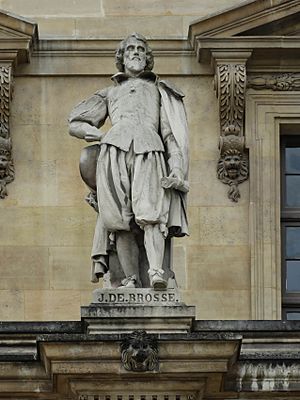Jean de Brosse facts for kids
Quick facts for kids
Jean de Brosse
|
|
|---|---|

Jean de Brosse statue at the Louvre, Paris, France.
|
|
| Born | 1375 Huriel, France |
| Died | 1433 (aged 57 or 58) Boussac, France |
| Allegiance | France |
| Rank | Marshal of France |
| Battles/wars | The Hundred Years War |
Jean de Brosse (1375–1433) was an important French knight and military leader. He was the Lord of Boussac, Sainte-Sévère, and Huriel. Jean de Brosse served as a trusted advisor and close friend to Charles VII of France, who later became king. Because of his bravery and skill, he was made a Marshal of France in 1426.
Contents
Early Life of Jean de Brosse
Jean de Brosse was born in 1375 at his father's castle in Huriel, France. His parents were Pierre II de Brosse and Marguerite de Malleval. When he was 44 years old, in 1419, Jean de Brosse married Jeanne de Naillac.
Fighting in the Hundred Years' War
Jean de Brosse began his military career fighting for France. He fought alongside his cousin, Louis de Culant. Thanks to his family's influence, Jean de Brosse became a special assistant to the Dauphin, who was the prince and future king, Charles VII. Jean de Brosse and Charles VII quickly became good friends.
In 1422, Jean de Brosse's father passed away. Jean then inherited his father's important titles and lands. In the same year, King Charles VI also died, and Charles VII became the new king, even though he hadn't been officially crowned yet. Jean de Brosse and his wife also welcomed their son, whom they named Jean, that year.
On May 16, 1423, King Charles VII gave Jean de Brosse a very important job: to make sure the king was safe. A few years later, on July 14, 1426, Jean de Brosse was given the high rank of Marshal of France. This meant he was one of the top military commanders. He fought against the English and their allies with other famous French leaders like La Hire, Jean de Dunois, Jean Poton de Xaintrailles, and Arthur de Richemont.
Jean de Brosse spent a lot of his own money on his army and on improving his castle in Boussac. The French government was also short on money and couldn't pay him back for his service. To keep fighting, he had to sell his valuable dishes, silver, and even his wife's jewelry. He also offered freedom to the people living in Boussac in exchange for money.
In 1428, Jean de Brosse took part in a small rebellion. However, it was quickly stopped, and the rebels were arrested. But because the king desperately needed skilled generals, they were soon forgiven.
Jean de Brosse and Joan of Arc
Jean de Brosse was among the French leaders trying to stop the English army. However, they were not successful, and in 1429, the English reached the city of Orléans. Joan of Arc wanted to help the king and lead the French army. With Jean de Brosse's strong encouragement, the king agreed to send Joan. Jean de Brosse and Louis de Culant escorted Joan, along with French troops, to join the main army. Under Joan of Arc's leadership, the French won the important Siege of Orleans. Because of his great help, Jean de Brosse was given a special place of honor at the king's coronation.
On May 24, 1430, Joan of Arc was captured by the enemy. Jean de Brosse tried very hard to convince the king to rescue her, but he couldn't. He spent all his money trying to gather an army to save her. He joined forces with Xaintrailles and Lahire, leading an army of 4,000 soldiers. They managed to free the city of Compiègne, but Joan of Arc was no longer there. She had been moved to Rouen, where she was tragically burned on May 30, 1431. Jean de Brosse tried to get revenge for Joan by attacking Rouen, but his plan failed. He then returned to Boussac.
Later Life and Passing
When Jean de Brosse arrived back at Boussac after his defeat, he learned that his wife had passed away. He was very sad and overwhelmed by everything that had happened. After this, he never left Boussac again for the rest of his life. He died in June 1433.
Jean de Brosse had many debts when he died. His creditors, the people he owed money to, threatened to dishonor his memory and scatter his remains. However, King Charles VII gathered enough money to pay off all the debts. Because of the king's help, Jean de Brosse's body was allowed to rest peacefully in the abbey at Prébenoît.
Marriage and Children
Jean de Brosse married Jeanne de Naillac on August 20, 1419. They had the following children:
- Jean II de Brosse, who married Nicole de Châtillon on June 18, 1437.
- Margaret, who married Germain de Vivonne, seigneur d'Anville.
- Blanche, who married Jean de Roye, seigneur de Muret.
See also
- Hundred Years War
- Charles VII
- Joan of Arc
- Siege of Orléans
- Saint-Benoît-du-Sault
- House of Rochechouart
- Château de Brosse

